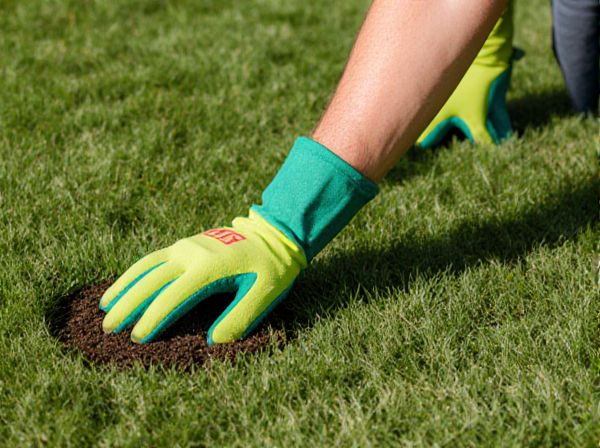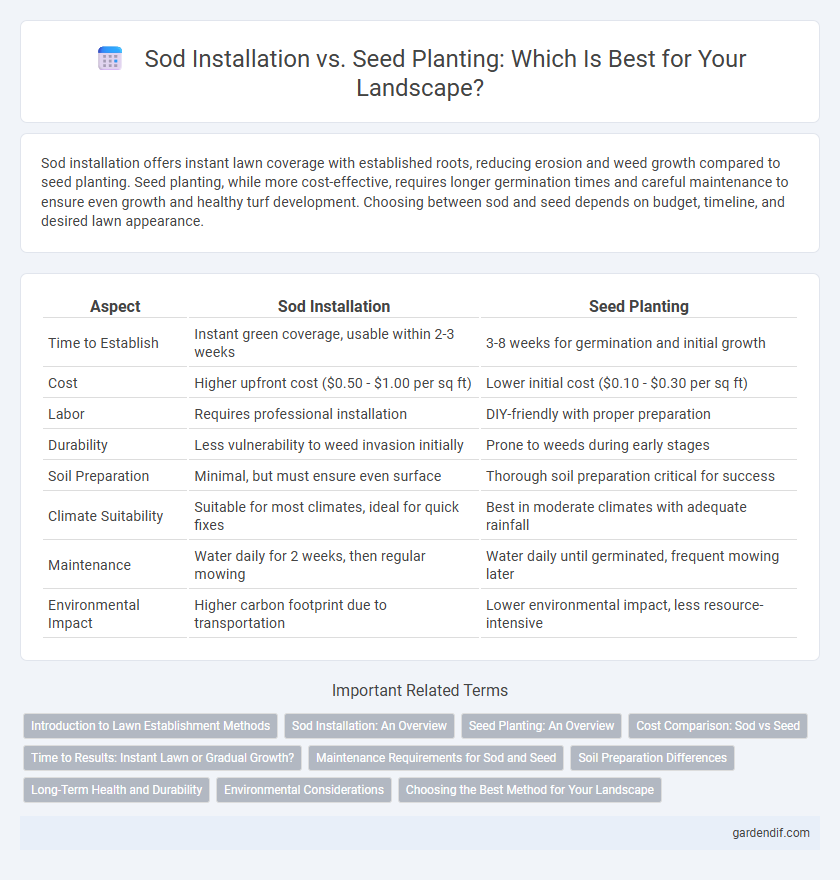
Sod Installation vs Seed Planting Illustration
Sod installation offers instant lawn coverage with established roots, reducing erosion and weed growth compared to seed planting. Seed planting, while more cost-effective, requires longer germination times and careful maintenance to ensure even growth and healthy turf development. Choosing between sod and seed depends on budget, timeline, and desired lawn appearance.
Table of Comparison
| Aspect | Sod Installation | Seed Planting |
|---|---|---|
| Time to Establish | Instant green coverage, usable within 2-3 weeks | 3-8 weeks for germination and initial growth |
| Cost | Higher upfront cost ($0.50 - $1.00 per sq ft) | Lower initial cost ($0.10 - $0.30 per sq ft) |
| Labor | Requires professional installation | DIY-friendly with proper preparation |
| Durability | Less vulnerability to weed invasion initially | Prone to weeds during early stages |
| Soil Preparation | Minimal, but must ensure even surface | Thorough soil preparation critical for success |
| Climate Suitability | Suitable for most climates, ideal for quick fixes | Best in moderate climates with adequate rainfall |
| Maintenance | Water daily for 2 weeks, then regular mowing | Water daily until germinated, frequent mowing later |
| Environmental Impact | Higher carbon footprint due to transportation | Lower environmental impact, less resource-intensive |
Introduction to Lawn Establishment Methods
Sod installation offers an instant, fully formed lawn by transplanting mature grass, providing immediate ground coverage and erosion control. In contrast, seed planting involves sowing grass seeds directly into prepared soil, allowing for greater variety of grass types and cost efficiency but requiring longer establishment time. Both methods demand proper soil preparation, watering, and maintenance to ensure healthy lawn development and durability.
Sod Installation: An Overview
Sod installation offers an instant lawn with mature grass, reducing erosion and weed growth compared to seed planting. This method provides quick ground cover, enhances soil stability, and establishes a uniform, dense turf within weeks. Proper site preparation and irrigation are critical to ensure successful sod rooting and long-term lawn health.
Seed Planting: An Overview
Seed planting offers a cost-effective and versatile solution for establishing a new lawn, allowing for customization with various grass species that are well-suited to local climate conditions. This method promotes deeper root growth, enhancing soil health and drought resistance over time. Seed planting requires patience and proper care, including regular watering and protection from pests, to achieve a lush, natural-looking turf.
Cost Comparison: Sod vs Seed
Sod installation typically costs between $0.30 and $0.80 per square foot, offering immediate lawn coverage but at a higher upfront price compared to seed planting, which ranges from $0.10 to $0.20 per square foot. Seed planting requires less initial investment but involves added expenses like soil preparation, watering, and longer maintenance to achieve full lawn establishment. Homeowners should weigh sod's faster results against seed's cost-effectiveness and longer growing period to determine the best option for their landscape budget.
Time to Results: Instant Lawn or Gradual Growth?
Sod installation delivers an instant lawn, transforming bare soil into a lush, green yard within hours, making it ideal for projects requiring immediate results. Seed planting involves gradual growth, with germination typically taking 7 to 21 days and full lawn establishment spanning several months. Sod requires more upfront investment but offers immediate curb appeal, while seed planting provides a cost-effective approach with a slower, natural development process.
Maintenance Requirements for Sod and Seed
Sod installation requires consistent watering and weekly mowing shortly after installation to ensure root establishment and prevent drying out. Seed planting demands more frequent watering, often multiple times daily, until germination occurs, along with careful weed control during early growth stages. Both methods benefit from regular fertilization, but seeded lawns generally require longer upkeep before achieving a mature, resilient turf.
Soil Preparation Differences
Sod installation requires a well-graded, smooth soil surface free of rocks and debris to ensure tight contact between the sod and soil, promoting immediate root establishment. Seed planting demands a finer, loosened soil tilth to allow seed-to-soil contact and adequate moisture retention for germination. Both methods necessitate the removal of weeds and thorough soil amendment with organic matter and nutrients to optimize growing conditions.
Long-Term Health and Durability
Sod installation provides immediate ground cover that reduces erosion and establishes a stronger root system faster than seed planting, leading to enhanced long-term lawn health and durability. Seed planting, while more cost-effective, requires careful maintenance and more time to develop resilient turf capable of withstanding wear and environmental stresses. For landscapes prioritizing lasting green coverage and minimized vulnerability to weeds, sod installation typically ensures superior long-term vitality and durability.
Environmental Considerations
Sod installation offers immediate erosion control and reduces water runoff by establishing a mature grass layer quickly, which is beneficial for preventing soil degradation. In contrast, seed planting requires more water and time to establish, increasing vulnerability to soil erosion and nutrient loss during the growth period. Choosing sod over seed can significantly minimize environmental impact in sensitive landscapes due to faster soil stabilization and reduced need for chemical fertilizers.
Choosing the Best Method for Your Landscape
Sod installation offers instant green coverage and erosion control, ideal for high-traffic areas and quick lawns, while seed planting provides cost-effective, customizable grass varieties that adapt better over time. Soil quality, climate, budget, and project timeline significantly impact the choice between sod and seed, requiring careful evaluation of local conditions and maintenance capacity. For a durable, low-maintenance lawn in urban or commercial landscapes, sod often delivers faster results, whereas seed planting suits large residential spaces prioritizing variety and environmental sustainability.
Sod Installation vs Seed Planting Infographic

 gardendif.com
gardendif.com